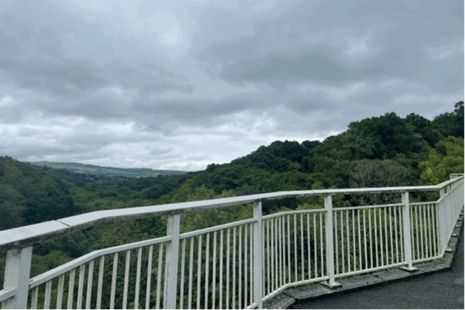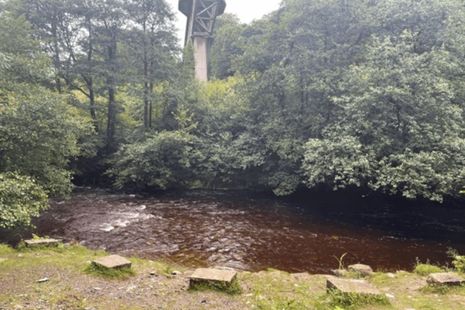The untold benefits of memory landscaping
Let memory landscaper Niall Quinn take you on a journey through his past as he walks through his favourite places

I’ve never had a particularly consistent memory. That truth was made clear to me last month, when I confidently proclaimed that a local village was to my east when, really, it was to my west, despite having lived in that area for 16 years. Yeah. But as for the history of the stone cross that lay before us at the time, I left no stone unturned. My solution? Something I have unceremoniously dubbed ‘memory landscaping’. What does it involve, you might ask? Let’s take a walk in the woods to find out.
After trotting down a rain-drenched trail, I arrive at a modern suspension bridge. A rugged valley that would have made even the Romantic poet William Wordsworth faint surrounds me. The whir of passing bikes merely prods its unmarred tranquillity. Hang on. What’s that noise? Faintly, I hear the cries of Winston Smith in the precinct of Room 101. After “Do it to Julia!” is bellowed, I hear not the clicking of a closing cage door. Instead, the gasp of my curious (if impressionable) sixteen-year-old self, desperately attempting to finish his near-overdue A Level English Literature coursework, overwhelms me.
“The utterances of Boris Johnson begin to swirl around the pot of memory that the valley has created”
What is going on, you might ask? The construction of the most convoluted analogy the world has ever witnessed? Before I’m met with a “Literally Nineteen Eighty-Four” and a dubious comparator, the sufferings of Winston and the turbulence of a naive teenager are eroded. I glance down toward the solitary, windswept riverbank below the bridge. The utterances of Downing Street’s former Raver-in-Residence, Boris Johnson, begin to swirl around the pot of memory that the valley has created. “You must … work event … you should say no … all guidance was followed completely … save our NHS …they fined me for having lunch” tarnishes those beloved pebbles and sticks. “No school for six months? What about the camping trip? Fancy a game of Warzone? It’s nearly time to clap! You should divorce your buzzcut, bey,” the reactions of a perplexed fifteen-year-old push de Pfeffel’s babbling aside. Something is brewing.
But before I find out what is being concocted, my attention is arrested by the bridge itself. I notice a sign. It reminds me that there once existed a Brunellian railway viaduct of 1857 in the current bridge’s place. Without warning, a blurred summation of a fierce childhood interest (addiction) in trains forces its way inside the mind. It’s made up of the roar of Mallards and the grating sound of a model HST speeding around a cluttered living room. This laughter-filled tidal wave is muted, however, by a dampening piece of information: the bridge fell silent in the 1960s, when the Government axed a plethora of railway lines to, among other things, save money. In turn, a drove of callow “Why don’t trains run here anymore? Humph. Aghhh! I hate Dr Beeching”-esque wails, accompanied by aggressive stomping, floods this portrait of innocence.

Still with me? Good. You might well be wondering ‘Either this guy has an unhealthy infatuation with bridges, needs to pick up a better hobby, or both.’ But before you dismiss this mnemonic bender any further, I’d like to defend it by highlighting its relevance for executing ‘memory landscaping’. Envision the process of landscape gardening. First, the landscaper devises a plan for the area they wish to landscape. Second, they commence digging. Third, they resurface the land, incrementally, in order to reshape it. Likewise, each of the three resident memories evoked – Nineteen Eighty-Four bewilderment, lockdown perplexion, and railway enthusiasm – all gained their place in the valley through a similar process. After I had finished a chapter of Nineteen Eighty-Four, I would recline on the bridge, mulling it all over, leaving an ounce of my green mind to dwell in the trees below. During lockdown, after having Boris’ quacking shovelled into my ears, I would exercise my thirty minutes of state-mandated exercise by sitting beside the stream. Henceforth, me, the stream, and lockdown were inextricably bound together. Ever since I learned of the railway bridge’s fate, it became a nexus point upon which my train interests could converge and coalesce.
“Actively tending to memories and letting them live in the landscape can be immensely gratifying”
And given that I revisited the bridge to write this article, my memory of writing it will join the bubbling pot. What was once an unfamiliar valley and bridge has become, over time, filled and reshaped with the vestiges of my time, memory and thought. It has been landscaped by my memories. Ever a tie dye of inward perception, a part of myself dwells inside the place. When I am absent, it hibernates. When I return, like today, it bears fruit, eagerly anticipating further cultivation. What was once firmly inside is now out.
We all have places in which our memories, good and bad, poke their little heads out. But actively tending to such memories – those external manifestations of the self – and letting them live in the landscape can be immensely gratifying. One often sees heartfelt memorial benches that read something along the lines of ‘X person loved sitting here and [insert activity]. RIP.’ By immortalising their personal relationship with space and place, passersby recognise that this person’s memories eternally dwell there. By sharing my own ‘Valley of the Mind’ I not only hope to do the same, but also to provide an impetus for more memory landscaping. If, miraculously, even just two people tend to their own memories in the same location, a special thing will be engendered indeed. Once shared, that place will forever house the mnemonic residue of those people.
In his behemoth poem of 1798, ‘Tintern Abbey’, Wordsworth crowned (or, rather, dropped) nature as “the anchor of my purest thoughts”. When one memory landscapes, this relationship is equalised. Rather than pinning them to the ground, landscape and thoughts become symbiotic. That symbiosis is a testament to how we, as humans, are forever embedded in the world around us. Take a walk and find your valley of memory. Just don’t forget to activate Strava.
 News / Cambridge welcomes UK rejoining the Erasmus scheme20 December 2025
News / Cambridge welcomes UK rejoining the Erasmus scheme20 December 2025 News / CUP announces funding scheme for under-represented academics19 December 2025
News / CUP announces funding scheme for under-represented academics19 December 2025 News / Caius mourns its tree-mendous loss23 December 2025
News / Caius mourns its tree-mendous loss23 December 2025 News / King appoints Peterhouse chaplain to Westminster Abbey22 December 2025
News / King appoints Peterhouse chaplain to Westminster Abbey22 December 2025 News / SU reluctantly registers controversial women’s soc18 December 2025
News / SU reluctantly registers controversial women’s soc18 December 2025








